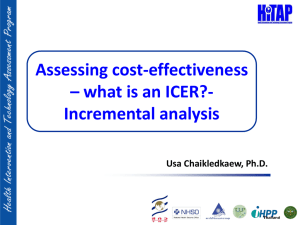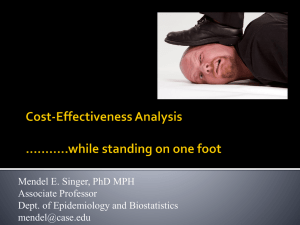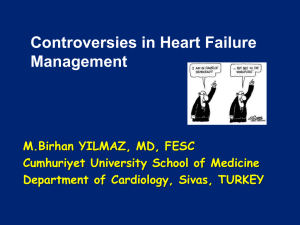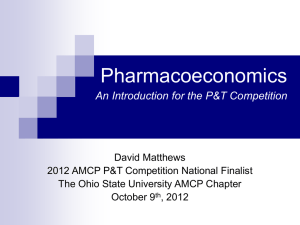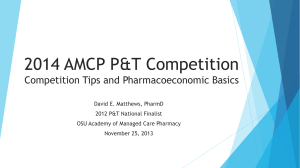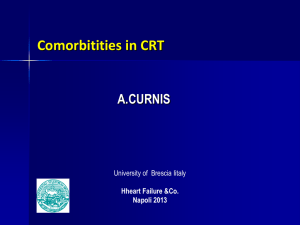Prospettive di Health Economics nell`ottimizzazione CRT CRT
advertisement
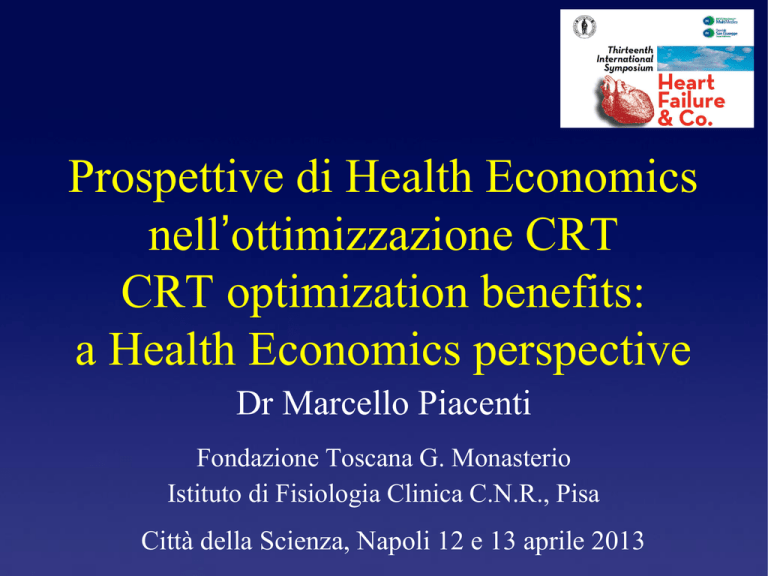
Prospettive di Health Economics nell’ottimizzazione CRT CRT optimization benefits: a Health Economics perspective Dr Marcello Piacenti Fondazione Toscana G. Monasterio Istituto di Fisiologia Clinica C.N.R., Pisa Città della Scienza, Napoli 12 e 13 aprile 2013 Medical economics is a discipline that provides conceptual and quantitative tools to address the problem of allocating scarce resources efficiently • Any resources committed to health care are no longer available to other uses • For the economist, cost is not an amount of money but rather the consumption of societal resources that are lost to any other use. Heart Failure Clin 2013;9:93-106 Cost-effectiveness analysis Cost-effectiveness analysis is a method of comparing incremental benefits and costs • Cost-effectiveness is measured in incremental terms and therefore requires the identification of an appropriate comparator • A therapy must be effective before it can be cost-effective • Because both costs and outcomes of a disease change with time, a cost-effectiveness study must capture all relevant costs and outcomes over the relevant time horizon Two types of cost-effectiveness analysis are performed • Based on randomized clinical trials (RCT): • cost and outcomes are prospectively collected with clinical data (QALYs) • characteristics of the pts recruited, selected centers performing the study, short follow-up • Based on decision-analytical modeling (DAM): • investigators design a mathematical model to recreate the natural history of the disease • permits to test the robustness of the results by subjecting the model to rigorous sensitivity analyses in which 1 or more input parameters are varied to test how this influences the reported results Considered Parameters • Analysis of outcome • QALYs (Quality Adjusted Life Years) • ICER (Incremental Cost-Effectiveness Ratio) • Analysis of cost/effectiveness QALYs = years x QoL ICER = C1-C2/E1-E2 C = cost E = QALYs gained or lost A hypothetical scenario to demonstrate the impact of the analytical time horizon on incremental costeffectiveness. (A) Cumulative costs, US Dollars. (B) Cumulative outcomes (quality-adjusted life years, QALYs). (C) Incremental cost-effectiveness ratio (ICER) at various time points (US Dollars per QALY). Willingness To Pay (WTP) J Am Coll Cardiol, 2009; 53:765-773, doi:10.1016/j.jacc.2008.11.024 Europace Advance Access published March 2013 At 1 year: 25% deaths or hospitalizations for HF within the group of pts not systematically optimized (group 2) 9% deaths or hospitalizations for HF within the group of pts systematically optimized (SonR or Echo) (group 1) Reduction of 65% of HF hospitalization with systematic AV delay optimization with sonR at 1 years F-U Banz et al 2005: Input parameters Economical aspects of AV-delay optimization in CRT: Optimization of CRT increase the efficacy of the treatment Systematic AV-delay and VV-delay optimization of CRT (by SonR or echocardiography) generates an increase of 0,1 QALYs annually1,2 compared to those patients without systematic optimization 1: Kurt Banz. Cardiac resynchronization Therapy (CRT) in Heart Failure-Amodel to Assess Economoc Value of this New Medical Technology. Value in Heath; Volume 8- Number 2-2005; 128-139 2: Delnoy PP et al: Clear clinical study post hoc. Europace Advance Access published March 2013 Comparison of CRT-D with standard optimization and CRT-D with SonR optimization vs optimal medical therapy: a simulation model proposed by Banz et al 2005 *OPT: optimal medical treatment ^cost of device included 1: Kurt Banz. Cardiac resynchronization Therapy (CRT) in Heart Failure-Amodel to Assess Economoc Value of this New Medical Technology. Value in Heath; Volume 8- Number 2-2005; 128-139 Comparison of CRT-D with standard optimization and CRT-D with SonR optimization vs optimal medical therapy: a simulation model proposed by Banz et al 2005 Δ QALY Incremental costeffectiveness ratio (ICER) = Cnew - Coll Effnew - Effold Incremental costeffectiveness ratio (ICER) = Cnew - Coll Effnew - Effold = 14.900 € 0,32 QALY Standard CRT-D = 15.058 € 0,52 QALY CRT-D SonR Incremental costeffectiveness ratio (ICER) = 15.058 € - 14.900 € 0,52 - 0,32 QALY = 790 €/QALY Sensitivity analysis of cost-effictiveness of CRT-D with SonR optimization vs Standard CRT-D: △ costs WTP Conclusions: • SonR optimization in CRT evaluated at 1 year of follow-up increases QALY by reducing hospitalization • The ICER of CRT-D with SonR vs CRT-D with standard optimization programming seems costeffective • The evolution of the SonR algoritm with weekly optimization of pacing parameters, both at rest and on effort, might increase even further the responder percentage and increase cost-effectiveness
